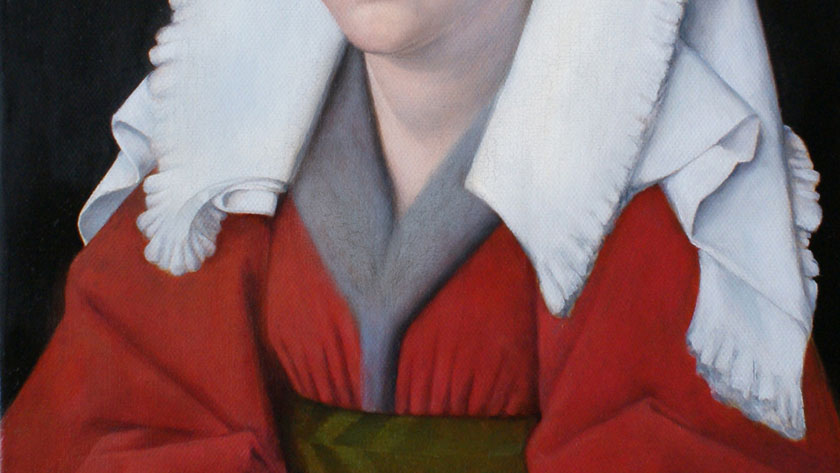Art Lesson 48, Part 3
Discover How to Paint Using the Flemish Method
Learn how to paint like the Old Masters!
Old Masters Academy Online Course
Self-study, self-paced online video courseLifetime membershipOne-time payment: $487Enroll Now!Personal Tutoring online + Online Course
Unlimited tutoring by the Academy teachersLifetime membershipOne-time payment: $997Enroll Now!« Back to the Art Lessons List
How to Paint a Drapery Over a Grisaille Underpainting – Glazing Layers
A Second glazing of the red dress goes over the first one. Make sure that the first glazing layer is dry. So you can continue glazing without mixing the two layers of glazing mechanically. Use rich red colors such as Alizarin Crimson to saturate the red colors of the dress.
You can intensify the color by glazing.

When Margareta’s face is made in dead colors we proceed to the red coat. For the red color we use Burnt Sienna, Cadmium Orange and a little Alizarin Crimson. Liquin Fine Details used as a solvent medium. Now, when the underpainting with all the necessary details is complete, we add red glazing, thus changing the color.
The red dress has its red color .So it’s time to highlight the folds of the dress with a lighter red paint. It’s better to use a small flat or a round brush for the purpose.
You had better use a certain system in mixing your paint. Try to set your palette the same way every time. So your brush will easily be able to find the necessary color, without hunting for it.

The White hood is rather difficult to paint. Different gradations of white have to be combined. Two brushes are used for the purpose. The two brushes are flat and the smaller one is for both white and light paint. With the help of the bigger clean and dry brush we can smooth the white paint across. The shape of the folds has to be observed. The shadows of the white hood are lighter then the light parts of the dark dress. Remember that all the colors and tones should relate to each other.

When painting on white cloth dirty colors can be inevitable. What’s the reason? A Dirty or muddy color may be the result of the following. One does not know how the colors may affect one another. So, you mix, and the color on the palette seems to be the right one, but on the canvas, you see a wrong color. You mix again and put it on the canvas; it mixes with the first tint and you get—mud. What has to be done? Scrape the whole thing off. Mix a fresh color and apply it on a clean spot of the canvas. Apply it fresh and plain, but do not sprinkle. As the result, you shall achieve a fresh and clean color.
Overmixing may sometimes result in a muddy color. Especially when more than three colors are mixed. So if you haven’t got the right tint with the three colors, then you’ve got the wrong ones. If it is not so, and you have to add a fourth color, then do. But be very attentive, otherwise you will have to mix the tint again.
The use of dirty brushes causes muddy colors. Don’t be too economical about the number of brushes you use. Keep a good big rag at hand, and wipe the paint off your brush often. If the color is getting muddy, clean your palette and take a clean brush.
It won’t be possible to mix colors with any degree of certainty if the palette is smeared with all sorts of different tints. Use your palette-knife—that’s what it’s for. Scrape the palette clean (every once in a while as it gets crowded. Wipe it off. Take some fresh brushes. But if the color is still dirty, then it is your own fault, not a matter of the tools.




